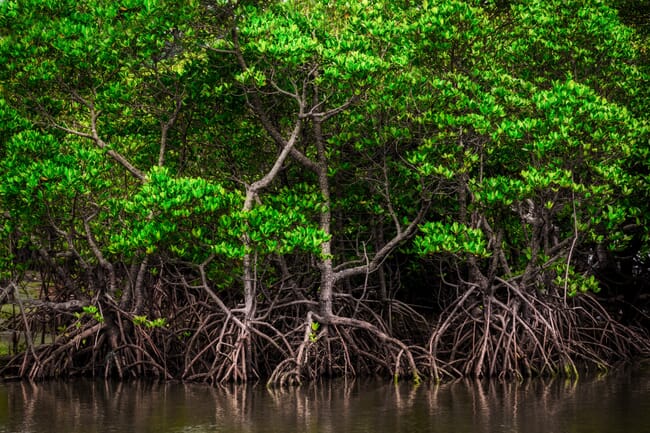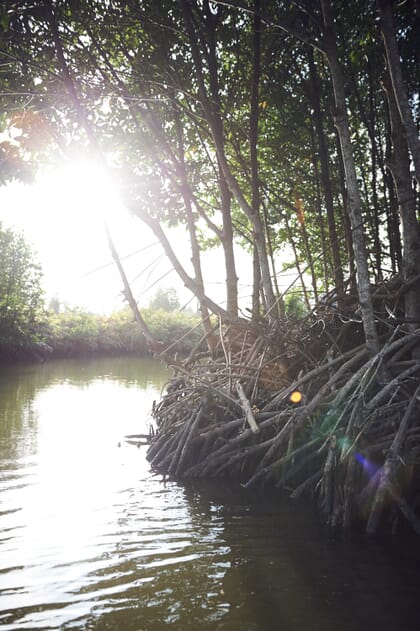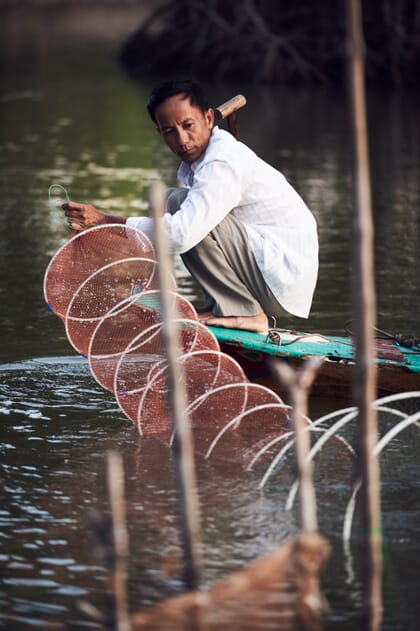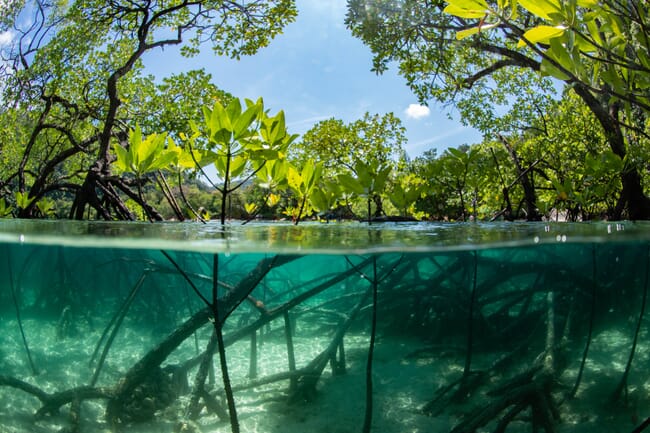
Dan Friess from the Centre for Nature-based Climate Solutions at the University of Singapore told delegates at the Economist’s World Ocean Summit Asia Pacific that a recent headline in The Guardian gave him pause. The 4 November headline read, “Blue carbon, the hidden CO2 sink that pioneers say could save the planet,”. He immediately wanted to re-draft it. “If I was to write that headline, I would have said, ‘Pioneering ecosystem method that can save the planet (a little bit)’.”
That sentiment was largely echoed by his fellow panellists Thomas Egli from Blueyou Consulting AG and Nikolas Stone from the CDC Group. During the panel discussion, they discussed how blue carbon projects – from shrimp farming in mangroves to windfarms – are being implemented across the Asia-Pacific region. In each instance, they have found that the initiatives are highly complex and specific to the environments they operate in – they couldn’t always be scaled or implemented globally.
All three were quick to say that blue carbon’s sequestration and climate mitigation potential is astonishing – but the projects aren’t suitable in all coastal environments. Egli stressed that implementing these projects requires flexibility and community buy-in. Splashy headlines could lead to inflated expectations from investors and policymakers, and lead to a harsh reality-check when the projects try to leave the pilot stage.

What are blue carbon projects trying to achieve?
“Blue carbon” refers to carbon that is naturally stored in coastal ecosystems – usually in waterlogged soils. The most common examples are habitats like mangroves, salt marshes and seagrass, but Friess says that other macroalgae and seabed ecosystems are also good candidates for sequestering carbon.
Blue carbon projects aim to harness the natural carbon capture ability of these ecosystems and use it to sequester emissions instead of releasing them into the atmosphere. This usually involves investing in habitat restoration and bioremediation and providing financial returns for the communities that maintain them. In a best-case scenario, blue carbon projects can make a positive economic and environmental impact on coastal communities, while mitigating the effects of climate change.
Blue carbon is gaining traction with green investors and policymakers because coastal ecosystems can store more carbon per hectare than other onshore habitats. This enhanced carbon sequestration is especially effective if policymakers are working with smaller landscapes and trying to maximise their returns. According to Friess, mangroves can store three to five times more carbon than tropical forests. Going blue gives climate mitigation initiatives, “more bang for their buck,” he says.
But despite blue carbon’s potential, there are some limitations. Though there’s a lot of interest from the corporate world and from national governments, there aren’t many bankable projects. “I can probably count on one hand the number of viable projects we have at this time,” Friess told delegates. The two most notable blue carbon projects are Mikoko Pamoja in Kenya and Cispatá Bay in Colombia. Both of these projects focus on replanting mangrove forests and are selling carbon credits as they expand.
While many seaweed producers are looking to cash in on blue carbon and carbon credits, the topic was – unfortunately – not covered in the discussion. The panel mainly focused on inter-tidal ecosystems rather than offshore ones.
The tangible and intangible benefits of blue carbon
Investing and financing blue carbon projects requires a change in thinking – concepts like assets, revenue streams and additional benefits are more nebulous in this space when compared to traditional investments. Blueyou’s Thomas Egli told delegates that financiers can understand and measure CO2 sequestration. But focusing on this metric obscures the other benefits of blue carbon, and these benefits are more difficult to assess.

Egli explained that ecosystem restoration brings multiple un-quantifiable advantages: it can make habitats more biodiverse, help communities become more resilient to climate change and provide employment. There aren’t any metrics or indicators for these benefits – so blue carbon practitioners don’t have an easy way to present this to investors.
Nikolas Stone saw this first-hand in his role as CDC Group’s director of environmental, social and governance investing. During his initial experience with blue carbon – developing a windfarm in Pakistan – he viewed the power generation as the main revenue stream and asset. His views quickly shifted when he saw an opportunity restore the landscape by re-planting mangroves.
The mangroves – and the benefits they provided – emerged as a business continuity and an asset that was worth safeguarding. It wasn’t solely about sequestering carbon. Maintaining them was a boon for the windfarm even though they initially appeared as a drain on the balance sheets.
The livelihood and climate adaption benefits added a lot of aggregate economic value – but this wasn’t well understood by investors. Going forward, he wants to see new research that identifies indicators for these intangible elements. “A bigger knowledge base will improve the business case for these projects and showcase what can be achieved on the ground,” he said.
Stone said that the costs of maintaining the ecosystem weren’t prohibitive. In his case study, CDC Group spent between $50,000 and $60,000 to plant the mangroves and train the locals to maintain them. This generated paid employment, helped secure community buy-in and ensured that a valuable asset was protected.
Stone estimates that the mangroves are worth between $7 million and $10 million. “When you start to marry off the operational costs you’re facing, which are tens of thousands of dollars, versus what you’re protecting, which is tens of millions of dollars, it starts to add up reasonably quickly from a business perspective,” he says.
Getting blue carbon off the ground
The three panellists are all aware of successful blue carbon pilots, but there aren’t any large-scale projects to date. When asked why the initiatives remain small, Friess said that there wasn’t one single stumbling block. In his experience, once you address one barrier, hundreds more emerge. “There isn’t just one thing that we can solve with a technical solution, unfortunately,” he told delegates.

According to Friess, Egli and Stone, gaining community buy-in and addressing the social, governance and economic factors are recurring stumbling blocks. Friess pointed out that there are opportunity costs when implementing a blue carbon initiative. This opportunity cost may not be worth the projected returns when compared to other ventures like aquaculture.
The initiatives aren’t as cut-and-dry when policymakers decide how to share the benefits of blue carbon either. A common dilemma is determining how much of the sequestered carbon is owned by the local community and how much to make available on the international market.
Friess explained that the viability of mangrove projects can be hindered if communities opt to use the carbon credits to offset local emissions instead of making them available to international buyers. In some cases, there isn’t a large domestic market for carbon credits. This curbs the financial returns for those who maintain the forests.
Marrying expectations with reality
From an economic perspective, Egli noted that the financing options for blue carbon can limit its scope. Blue carbon initiatives don’t usually operate with grants – the investment comes in loans. These loans carry due diligence provisions and require lengthy impact statements. Securing the funds is difficult and according to Egli, this limits their utility.
He went on to say that some of the funds will only finance projects that yield double-digit returns on investment (ROI). “We work in food production – you aren’t going to find anywhere that has double-digit ROI. That isn’t how it works on the ground, especially for small-scale aquaculture farmers,” he told delegates. “I don’t know if the finance community has changed enough and adapted to the realities of the environment and the requirements of the field.”
Stone agreed that more work needs to be done to bridge the gap between financial requirements and carbon capture reality. His main focus will be mitigating the financial risks of these projects or finding ways to make the risk more palatable to investors. He explained that the capital is there – but financiers need to show investors how their money will work and deploy the capital meaningfully.
Looking beyond the hype
Friess told delegates that the aquaculture sector, policymakers and financiers need to be realistic about blue carbon’s potential. It isn’t available for all countries and the popular hype could lead to inflated expectations. “Nature-based solutions aren’t a get-out-of-jail-free card for doing the hard work of decarbonising our economies,” he said.

Friess explained that on a global scale, blue carbon is quite limited. Of all vegetated ecosystems that sequester, between 1 percent and 1.5 percent are blue carbon ecosystems. The method can work wonders at a local level, but there’s a lot of complexity when it comes to scaling these projects. Practitioners and investors must be practical and recognise that blue carbon is one of many tools. It isn’t a silver bullet.
Egli echoed many of Friess’ caveats when talking about his on-the-ground efforts to marry aquaculture with blue carbon. Blue carbon projects have to be flexible and adaptable to the contexts they operate in. Securing local buy-in is essential and means that practitioners must address the community’s concerns as they operate.
He explained that the decision isn’t whether to plant mangroves or embark on a shrimp farming project – Blueyou has to do both simultaneously. Egli and his colleagues can’t simply re-plant a mangrove forest next to a shrimp farm and expect it to be successful. The farmer needs to be involved in the project for it to fulfil its carbon sequestration and food production goals.
“We all have to stay within reality and listen to each other,” Egli said. Aquaculture producers, scientists and developers need to be adaptable and sometimes compromise their expectations. If carbon credits aren’t securing local buy-in, investors might consider reduced farm insurance premiums or issuing green bonds. Stakeholders must be inventive and “there needs to be communication both ways,” Egli concluded.
Friess concluded by saying that policymakers and investors need to recognise the constraints of blue carbon along with its potential. Blue carbon can deliver great returns for communities but isn’t suitable for every coastal habitat. “Let’s be realistic, let’s get it right, and then we can unlock that potential.”
The Economist’s World Ocean Summit Asia Pacific is running from 6 to 10 December




